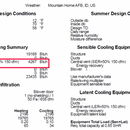Manual J – ERV Load
Hello all,
I’m reviewing the Man. J for the house. The house will have an ERV pulling in fresh air. So, I found a ASHRE calculator to find out what the ventilation ‘should’ be.
RedCalc.com Inputs:
Mountain Home ID – shielding factor 0.63
Floor area – 2,180
Occupants – 4
Bldg ht – 9 ft
ACH50 Measured Leakage (will measure once sealed up) – 327 CFM
Eff. annual avg. infiltration 11.2
Required total – 95.4
Infiltration credit – 11.2
RESULT
Req’d Mech. Vent – 84.2 CFM
I figured the following
Exhaust per room:
TOTAL – 130 CFM
I figured that a 150 CFM ERV would work and provide some extra capacity. The thought is to run the ERV at the 84.2 number (just above 50% capacity) and adjust for comfort.
The Manual J shows a 4,267 Btuh heating load for the “Cent. Vent…” (see summary below).
Heating Summary (image also atch’d)
Structure – 19,168 Btuh
Ducts – 0 Btuh
Central vent (SER=50% 150 cfm) Energy recovery – 4,267 Btuh
Humidification – 0 Btuh
Equipment load – 23,435 Btuh
Can someone help me understand if the “Cent Vent” info. is from the ERV? And, if so, explain if the “SER=50%” piece indicates the ERV is running at 50% of full capacity?
V/r,
WD
GBA Detail Library
A collection of one thousand construction details organized by climate and house part










Replies
That looks like they are using 50% efficiency and 150CFM. The BTU number looks to be in the ballpark for that amount of flow.
With a decent ERV and lower flowrate, you should be closer to about 2000BTU.
Akos - please let me know if I am understanding what you are saying.
The "50%" is the efficiency rating that they are using for the ERV. So, the 4,267 Btuh number is correct, but it may be that the ERV efficiency could be better (i.e. 70-90% vs 50%) AND we can use a lower flow rate.
1. More efficient ERV would mean that the air that is brought in would require less 'work' from the heating to bring the outside air up to temperature. So, the 4,267 would be reduced in kind.
2. Lower flow rate would have a similar affect in that less cold air would be coming in that needs to be heated. So, the btuh would/could be lower.
I am a bit confused about where the flow rate is derived.
3. Does the 4,267 Btuh come from the amount of air that we are 'changing' per hour with the 80 - 150 CFM ERV number that I mentioned in my OP?
4. Should the "flow rate" of the ERV be presented somewhere on the Man J. or is that basically what they are showing with the "Central vent (SER=50% 150 cfm) Energy recovery" line in my OP?
I was looking at a Fantech VER150 online, but I didn't see any SER/efficiency ratings on the spec. sheet (https://shop.fantech.net/upload/assets/445318_VER150_SPEC_SHEET_EN.PDF?8409cfb6). Can you recommend a place to find ERV efficiency info?
Thanks Again!!!!
You can find efficiency ratings here https://www.hvi.org/hvi-certified-products-directory/section-iii-hrv-erv-directory-listing/
Looks like the FanTech 150 is 75% efficient @0°C for max 64CFM
(Ran across this post as I’m researching impact of continuous ventilation on Man J calc)
Although a bit old, this will surely come up again. The basic calculation for the BTU/hr load is:
delta T (temperature difference) * CFM (how much air are you heating? Multiply by 60 to convert to CF per hr) * efficiency of ERV (how much heat are you retaining?) * BTU/(CF * deg F) (heat content of air). In the case above:
58 degF * (150 cfm * 60 min/hr) * .50 * 0.018 BTU/(cfm-degF) = 4698 BTU/hr
If building at altitude, you should correct the heat content of air for altitude since air is less dense at higher altitudes - about 3.5% per 1,000'. The ~10% difference between 4698 and 4267 suggests you're building at about 3,000 ft.